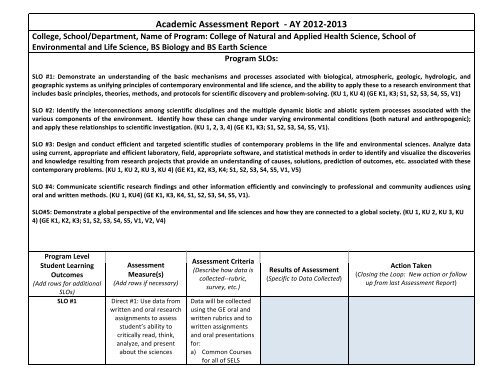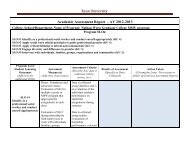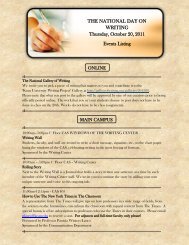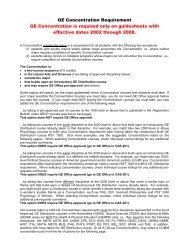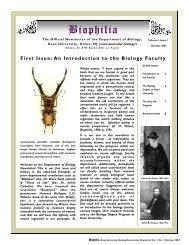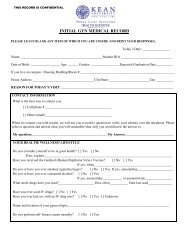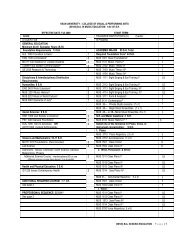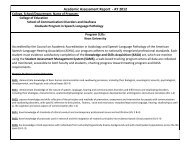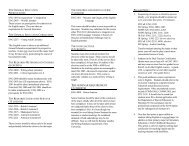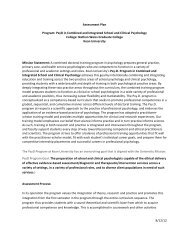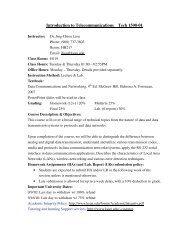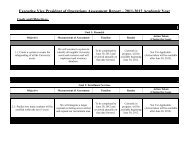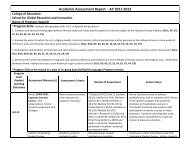Academic Assessment Report -â AY 2012-â2013 - Kean University
Academic Assessment Report -â AY 2012-â2013 - Kean University
Academic Assessment Report -â AY 2012-â2013 - Kean University
Create successful ePaper yourself
Turn your PDF publications into a flip-book with our unique Google optimized e-Paper software.
<strong>Academic</strong> <strong>Assessment</strong> <strong>Report</strong> -‐ <strong>AY</strong> <strong>2012</strong>-‐2013 <br />
College, School/Department, Name of Program: College of Natural and Applied Health Science, School of <br />
Environmental and Life Science, BS Biology and BS Earth Science <br />
Program SLOs: <br />
SLO #1: Demonstrate an understanding of the basic mechanisms and processes associated with biological, atmospheric, geologic, hydrologic, and <br />
geographic systems as unifying principles of contemporary environmental and life science, and the ability to apply these to a research environment that <br />
includes basic principles, theories, methods, and protocols for scientific discovery and problem-‐solving. (KU 1, KU 4) (GE K1, K3; S1, S2, S3, S4, S5, V1) <br />
SLO #2: Identify the interconnections among scientific disciplines and the multiple dynamic biotic and abiotic system processes associated with the <br />
various components of the environment. Identify how these can change under varying environmental conditions (both natural and anthropogenic); <br />
and apply these relationships to scientific investigation. (KU 1, 2, 3, 4) (GE K1, K3; S1, S2, S3, S4, S5, V1). <br />
SLO #3: Design and conduct efficient and targeted scientific studies of contemporary problems in the life and environmental sciences. Analyze data <br />
using current, appropriate and efficient laboratory, field, appropriate software, and statistical methods in order to identify and visualize the discoveries <br />
and knowledge resulting from research projects that provide an understanding of causes, solutions, prediction of outcomes, etc. associated with these <br />
contemporary problems. (KU 1, KU 2, KU 3, KU 4) (GE K1, K2, K3, K4; S1, S2, S3, S4, S5, V1, V5) <br />
SLO #4: Communicate scientific research findings and other information efficiently and convincingly to professional and community audiences using <br />
oral and written methods. (KU 1, KU4) (GE K1, K3, K4, S1, S2, S3, S4, S5, V1). <br />
SLO#5: Demonstrate a global perspective of the environmental and life sciences and how they are connected to a global society. (KU 1, KU 2, KU 3, KU <br />
4) (GE K1, K2, K3; S1, S2, S3, S4, S5, V1, V2, V4) <br />
Program Level <br />
Student Learning <br />
Outcomes <br />
(Add rows for additional <br />
SLOs) <br />
SLO #1 <br />
<strong>Assessment</strong> <br />
Measure(s) <br />
(Add rows if necessary) <br />
Direct #1: Use data from <br />
written and oral research <br />
assignments to assess <br />
student’s ability to <br />
critically read, think, <br />
analyze, and present <br />
about the sciences <br />
<strong>Assessment</strong> Criteria <br />
(Describe how data is <br />
collected-‐-‐rubric, <br />
survey, etc.) <br />
Data will be collected <br />
using the GE oral and <br />
written rubrics and to <br />
written assignments <br />
and oral presentations <br />
for: <br />
a) Common Courses <br />
for all of SELS <br />
Results of <strong>Assessment</strong> <br />
(Specific to Data Collected) <br />
Action Taken <br />
(Closing the Loop: New action or follow <br />
up from last <strong>Assessment</strong> <strong>Report</strong>)
students: <br />
• SELS 1000—<br />
Scientific Integrity <br />
• SELS Sections of <br />
GE2024—Research <br />
and Technology. <br />
• SELS 2XXX—<br />
Research Methods <br />
in the <br />
Environmental <br />
Science (not <br />
through the <br />
CNAHS curriculum <br />
committee yet). <br />
• SELS 4XXX Senior <br />
Research new <br />
Capstone that is <br />
not through the <br />
CNAHS curriculum <br />
committee yet. <br />
Direct Measure #2: Assess <br />
evidence for students <br />
demonstrating content <br />
knowledge using <br />
previously used, but <br />
recent, ACT science <br />
assessment tools, and <br />
science subject-‐specific <br />
ETS national assessment <br />
b) Entry-‐level courses <br />
common for all BS <br />
Biology majors and <br />
entry-‐level courses <br />
common for all BS <br />
Earth Science <br />
majors: <br />
• BIOS 1200, 2201, <br />
2202 <br />
• GEOS 1100 and <br />
2101 <br />
a) For all SELS <br />
Freshmen <br />
beginning in Fall <br />
<strong>2012</strong>, we will <br />
have them take <br />
an old ACT <br />
subject exam to <br />
gauge the level of <br />
preparedness of
tools <br />
the students for <br />
university-‐level <br />
science. <br />
b) In the Fall of <br />
<strong>2012</strong>, we will also <br />
begin <br />
administering a <br />
‘before and after’ <br />
assessment <br />
strategy by giving <br />
all SELS the <br />
Freshmen the <br />
appropriate ETS <br />
National Subject <br />
Exam. This <br />
assessment will <br />
also be given <br />
assessment upon <br />
completion of the <br />
entry level <br />
sequences. Our <br />
interest is to <br />
gauge the level of <br />
improvement in <br />
student <br />
knowledge after <br />
completing the <br />
sequence. <br />
c) Beginning in <br />
Summer, 2013, <br />
new Transfer <br />
students entering <br />
<strong>Kean</strong> will also <br />
need to take this <br />
exam. Transfer <br />
students and <br />
<strong>Kean</strong> direct entry <br />
students at that <br />
time who score <br />
below the <br />
national 50 th<br />
percentile on any
of the different <br />
areas of <br />
knowledge will <br />
need to complete <br />
an individually <br />
developed IEP <br />
(Individual <br />
Education Plan) in <br />
the summer in <br />
order to take <br />
upper division <br />
courses. <br />
d) We will also give <br />
the ETS specific <br />
subject <br />
assessments to <br />
all SELS seniors in <br />
the Senior <br />
Research course <br />
to determine the <br />
level of retention <br />
of the basic <br />
concepts in the <br />
environmental <br />
and life sciences. <br />
Indirect: Graduating <br />
Student Survey <br />
We will focus on the <br />
responses of students <br />
to the following <br />
questions, with mean <br />
scores of 1.5 (I being <br />
the best score, 5 being <br />
the lowest): <br />
• the ability to <br />
demonstrate basic <br />
knowledge as
SLO #2 <br />
Direct #1: Use data from <br />
written and oral research <br />
assignments to assess <br />
student’s ability to <br />
critically read, think, <br />
analyze, and present <br />
about the sciences <br />
unifying principles; <br />
• the ability to <br />
identify <br />
interconnections <br />
among disciplines; <br />
• the ability to <br />
design and <br />
conduct research; <br />
• the ability to apply <br />
the latest <br />
computation and <br />
lab methods; <br />
• the ability to <br />
communicate <br />
scientific results; <br />
• and demonstrate a <br />
global perspective <br />
of science <br />
Data will be collected <br />
from the same classes <br />
mentioned above for <br />
SLO #1 Direct Measure <br />
#1, using the GE oral <br />
and written rubrics <br />
and to written <br />
assignments and oral <br />
presentations. <br />
However, we will add <br />
to this rubric specific <br />
components to assess <br />
for students abilities to <br />
identify the: <br />
• interconnections <br />
among scientific <br />
disciplines; <br />
• the biotic and <br />
abiotic processes of <br />
the environment; <br />
• how these can <br />
change due to
SLO #3 <br />
Indirect: Graduating <br />
Student Survey <br />
Direct #1: Use data from <br />
written and oral research <br />
assignments to assess <br />
student’s ability to <br />
critically read, think, <br />
natural and <br />
anthropogenic <br />
disturbances; <br />
• how to apply these <br />
relationships to <br />
scientific <br />
investigation <br />
We will focus on the <br />
responses of students <br />
to the following <br />
questions, with mean <br />
scores of 1.5 (I being <br />
the best score, 5 being <br />
the lowest): <br />
• the ability to <br />
demonstrate basic <br />
knowledge as <br />
unifying principles; <br />
• the ability to <br />
identify <br />
interconnections <br />
among disciplines; <br />
• the ability to <br />
design and <br />
conduct research; <br />
• the ability to apply <br />
the latest <br />
computation and <br />
lab methods; <br />
• the ability to <br />
communicate <br />
scientific results; <br />
• and demonstrate a <br />
global perspective <br />
of science <br />
Data will be collected <br />
from the same classes <br />
mentioned above for <br />
SLO #1 Direct Measure <br />
#1, using the GE oral
analyze, and present <br />
about the sciences <br />
Direct Measure #2: Use <br />
data from scores on the <br />
lab portions of courses <br />
and written rubrics <br />
and to written <br />
assignments and oral <br />
presentations. <br />
However, we will add <br />
to this rubric specific <br />
components to assess <br />
for students abilities <br />
concerning: <br />
• Research project <br />
identification, design <br />
and implementation; <br />
• Data analysis; <br />
• Ability to identify <br />
critical results from <br />
the data and apply <br />
these to an <br />
understanding of <br />
causes, possible <br />
solutions, and <br />
prediction of <br />
outcomes associated <br />
with these <br />
contemporary <br />
problems. <br />
We will assess student <br />
performance on the <br />
lab component of the <br />
entry level sequence <br />
courses, common SELS <br />
courses (as <br />
appropriate) and <br />
select upper division <br />
courses that focus on <br />
research methods. We <br />
will use a rubric that <br />
assesses the different <br />
components necessary <br />
for the students to <br />
understand in order to <br />
conduct scientific
esearch. Specifically, <br />
we will focus on <br />
student abilities to: <br />
• identify questions or <br />
problems and pose <br />
hypotheses; <br />
• design and <br />
implement research <br />
projects; <br />
• analyze data; <br />
• draw appropriate <br />
conclusions; <br />
• identify next <br />
research steps. <br />
SLO #3 Indirect Measure <br />
#1. We will use the <br />
Graduating Student <br />
Survey. <br />
We will focus on the <br />
responses of students <br />
to the following <br />
questions, with mean <br />
scores of 1.5 (I being <br />
the best score, 5 being <br />
the lowest), that are <br />
the most relevant to <br />
being able to show <br />
success in this SLO: <br />
• the ability to <br />
design and <br />
conduct research; <br />
• the ability to apply <br />
the latest <br />
computation and <br />
lab methods; <br />
• the ability to <br />
communicate <br />
scientific results.
SLO #4 <br />
Direct #1: Use data from <br />
written and oral research <br />
assignments to assess <br />
student’s ability to <br />
critically read, think, <br />
analyze, and present <br />
about the sciences <br />
Indirect Measure #1. We <br />
will use the Graduating <br />
Student Survey. <br />
Data will be collected <br />
from the same classes <br />
mentioned above for <br />
SLO #1 Direct Measure <br />
#1, using the GE oral <br />
and written rubrics <br />
and to written <br />
assignments and oral <br />
presentations. <br />
However, we will add <br />
to this rubric specific <br />
components to assess <br />
for students abilities to <br />
identify, address and <br />
communicate <br />
environmental and life <br />
science issues, <br />
research results, and <br />
solutions to problems <br />
and questions in <br />
writing and oral <br />
presentations at an <br />
appropriate level. <br />
We will focus on the <br />
responses of students <br />
to the following <br />
questions, with mean <br />
scores of 1.5 (I being <br />
the best score, 5 being <br />
the lowest), that are <br />
the most relevant to <br />
being able to show <br />
success in this SLO: <br />
• the ability to <br />
design and <br />
conduct research; <br />
• the ability to
communicate <br />
scientific results. <br />
SLO #5 <br />
Direct #1: Use data from <br />
written and oral research <br />
assignments to assess <br />
student’s ability to <br />
critically read, think, <br />
analyze, and present <br />
about the sciences <br />
Data will be collected <br />
from the same classes <br />
mentioned above for <br />
SLO #1 Direct Measure <br />
#1, using the GE oral <br />
and written rubrics <br />
and to written <br />
assignments and oral <br />
presentations. <br />
However, we will add <br />
to this rubric specific <br />
components to assess <br />
for students abilities to <br />
• identify, address <br />
and communicate <br />
environmental and <br />
life science issues <br />
that are of a global <br />
concern; <br />
• understand and <br />
visualize local, <br />
regional, national <br />
and global patterns <br />
associated with the <br />
environment, and <br />
the effects of <br />
human/animal and <br />
environmental <br />
interactions;
Indirect Measure #1. We <br />
will use the Graduating <br />
Student Survey. <br />
We will focus on the <br />
responses of students <br />
to the question of <br />
their ability to <br />
demonstrate a global <br />
perspective of science. <br />
We will target a mean <br />
score of 1.5 (I being the <br />
best score, 5 being the <br />
lowest).


